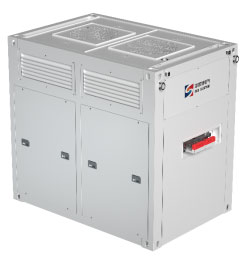CCS Motor Static VFD Frequency Converter Working Principle
(2024年04月09日)https://www.ccs-motors.com/ccs-motor-static-vfd-frequency-converter-working-principle.html
In the realm of electrical engineering, the evolution of technology has given rise to innovative solutions that redefine the way we manipulate and utilize electrical energy. One such groundbreaking device is the static frequency converter, a marvel without rotating parts, also known as a solid-state VFD frequency converter. This article explores the working principle of CCS Motor static VFD frequency converters, shedding light on their components, applications, and the transformative role they play in the domain of electrical energy conversion.
Understanding the static frequency converter working principle
Unlike traditional frequency converters with rotating parts, VFD frequency converter operates without any mechanical components in motion. Their working principle relies on advanced semiconductor technology to convert the input frequency, typically at 60 Hertz, into a single output frequency. This revolutionary approach eliminates the need for cumbersome and maintenance-intensive rotating parts, contributing to enhanced reliability and efficiency.
Non-Rotating Parts
The hallmark of static VFD frequency converters is the absence of rotating parts. Instead, these devices utilize semiconductor technology to manipulate the electrical signal and generate the desired frequency output. By employing solid-state components, solid state frequency converters achieve frequency conversion without the wear and tear associated with traditional rotating converters.
Generate Desired Current
In practical terms, static frequency converters excel at generating the current components required for a specific frequency. Through meticulous control and modulation of the electrical signal, these devices produce the desired frequency output while minimizing unwanted current components. This precision is crucial for ensuring the compatibility and efficiency of the converted electrical energy.
Wide Application
The versatility of static frequency converters is a key attribute that sets them apart in the realm of electrical engineering. These devices find application in a myriad of scenarios involving the generation, transmission, distribution, and utilization of electrical energy. Whether it's adjusting the frequency for specialized industrial machinery or synchronizing power grids with varying frequencies, static frequency converters play a pivotal role in diverse applications.
Components
The components that make up static frequency converters are integral to their seamless operation. These components include transformers, converters, and DC power supplies. Transformers play a crucial role in stepping up or stepping down the voltage as needed, converters manipulate the frequency, and DC power supplies ensure a stable and reliable power source for the conversion process.
In practical terms, the working synergy of these components enables static frequency converters to perform precise and efficient frequency conversion, meeting the diverse needs of different electrical systems.
The working principle of static frequency converters represents a paradigm shift in the field of electrical engineering. CCS Motor, at the forefront of technological innovation, has harnessed the power of semiconductor technology to create devices that redefine the conversion of AC electrical energy. By eliminating rotating parts and embracing a solid-state approach, static frequency converters offer a reliable, efficient, and versatile solution for adapting electrical frequencies to meet the demands of various applications.
As we navigate the ever-evolving landscape of electrical technology, the role of static frequency converters becomes increasingly pivotal. The transformative impact of these devices extends beyond simple frequency conversion; they stand as a testament to the ingenuity of CCS Motor power control equipment company in providing cutting-edge solutions that propel industries toward a future of enhanced efficiency and reliability in the realm of electrical energy conversion.

- このできごとのURL:


コメント